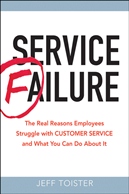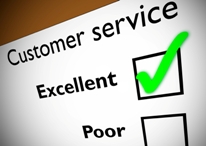
Every year I compile a list of tips for getting better customer service during the holiday season. This year, I decided to ask for tips from some of the customer service authors and bloggers I admire most. Their wonderful suggestions form a list that is sure to result in outstanding customer service.
Treat employees with respect (Patrick Maguire)
Patrick Maguire’s terrific blog, I’m Your Server Not Your Servant, highlights customer service experiences from the employees’ point of view. He reminds us that getting better service starts with treating employees with respect.
We need to remember that human workers are not the same as self-checkout stations, and that workers should be treated with the same mutual respect that we would expect if we were doing their jobs. If you treat workers with common courtesy and make a sincere effort to have some fun and make a genuine connection with them, your chances of receiving excellent service will improve dramatically.
Be engaging (Steve Curtin)
Visit Steve Curtin’s customer service blog and you’ll see a picture of him holding a pineapple. Why a pineapple? The pineapple is a universal symbol of hospitality. (Seriously, who could get upset when there is a pineapple involved?) Naturally, he recommends being a more hospitable customer.
When a customer glances at an employee’s name tag and uses her name at the beginning of the interaction along with a smile and eye contact, it has a disarming effect that quickly breaks the ice. The customer may also ask, “How is your day?” or compliment the employee by saying, “You look like the one in charge...” Just as employees tend to reflect the dispositions of their supervisors (for better or worse), they can also reflect the dispositions of the customers they serve.
Be reasonable (Shep Hyken)
Shep Hyken, best-selling author of the Amazement Revolution, also writes a very insightful customer service blog. One of his suggestions is that a reasonable customer will almost always get better service.
Let’s start with a confrontational situation to illustrate the point. There is an old story that goes something like this:
A passenger approached the airline representative about his lost luggage. Obviously upset, he more than complained. He yelled and made derogatory remarks about the airline. The airline employee’s response was simple. “Sir, I can see you’re upset. Right now there are only two people who care about your lost luggage and you are starting to make one of them upset.”
The moral of the story is that as a customer, you can’t get what you want by being unreasonable. If there is a problem, a level headed approach with reasonable suggestions will always win over confrontational arguments.
Place your irritability on hold before complaining (Guy Winch)
Sometimes, we have customer service complaints that need to be resolved. Who better to give advice on complaint resolution than Guy Winch, a psychotherapist who literally wrote the book on how to complain the right way (check out The Squeaky Wheel)? Here are complaint tips from an article he wrote for Psychology Today on how to resolve Christmas shopping complaints.
Complaint in person: “We should arm ourselves with receipts, patience, civility, and authentic smiles.”
Complaint via toll-free hotline: “We should place our irritability on hold (even if we are placed there too), remain calm and present the facts simply.”
Complaint via Twitter: “If you do tweet a complaint about a company, be fair, especially if you have oodles of followers. Remember, frustration fades but tweets are forever.
Don’t take yourself too seriously (Write the Company)
Write the Company’s blog features witty customer service correspondence with real companies. Read between the lines and you’ll realize that his tip is a great reminder to not take ourselves too seriously.
Getting better customer service during the holidays requires a secret weapon. This should not be confused with producing a concealed weapon, which has also proven to be very effective in getting the full attention of service personnel. One secret weapon to consider is sympathy. Not for the service representative, for yourself. You'll be amazed by how much faster and more compassionately you'll be treated by simply taping a slightly soiled white gauze pad over an eye or applying fake blood under your nose with even more on a tissue. Holidays are a crazy time to be a customer, so go crazy!
Enjoy the holidays and good luck getting outstanding customer service this holiday season!
 Jeff Toister
Jeff Toister  Wednesday, January 4, 2012 at 7:28AM |
Wednesday, January 4, 2012 at 7:28AM |  With so many holidays like Christmas, Hanukkah, New Years, and Festivus, December is obviously a time of year when many people take a few days off from work. When you are out of the office it is important to set appropriate expectations about when you might return a phone call or email. Otherwise, you may cause someone to anxiously wait for your response and even think a little less of you when they don't hear back.
With so many holidays like Christmas, Hanukkah, New Years, and Festivus, December is obviously a time of year when many people take a few days off from work. When you are out of the office it is important to set appropriate expectations about when you might return a phone call or email. Otherwise, you may cause someone to anxiously wait for your response and even think a little less of you when they don't hear back.





